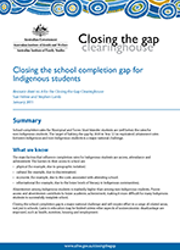Summary
School completion rates for Aboriginal and Torres Strait Islander students are well below the rates for non-Indigenous students. The target of halving the gap by 2020 in Year 12 (or equivalent) attainment rates between Indigenous and non-Indigenous students is a major national challenge.
What we know
The main factors that influence completion rates for Indigenous students are access, attendance and achievement. The barriers to their access to school are:
- physical (for example, due to geographic isolation);
- cultural (for example, due to discrimination);
- economic (for example, due to the costs associated with attending school);
- informational (for example, due to the lower levels of literacy in Indigenous communities).
Absenteeism among Indigenous students is markedly higher than among non-Indigenous students. Poorer access and absenteeism contribute to lower academic achievement, making it more difficult for many Indigenous students to successfully complete school. Closing the school completion gap is a major national challenge and will require effort in a range of related areas, not just in schools. Gains in education may be limited unless other aspects of socioeconomic disadvantage are improved, such as health, nutrition, housing and employment.
What works
Research in Australia and overseas points to strategies in three main areas that have shown to be effective in secondary schools for increasing engagement, achievement and school completion among Indigenous students:
- a school culture and leadership that acknowledges and supports Indigenous students and families, including
- a shared vision for the school community
- high expectations of success for both staff and students
- a learning environment that is responsive to individual needs
- a drive for continuous improvement
- involvement of the Indigenous community in planning and providing education
- school-wide strategies that work to maintain student engagement and improve learning outcomes, including
- broad curriculum provision
- quality vocational education and training (VET) options
- school absenteeism and attendance programs
- quality career education
- student-focused strategies that directly meet the needs of students at risk of low achievement or early leaving, including
- targeted skill development
- mentoring
- school engagement programs
- welfare support
- intensive case management.
What doesn’t work
The following strategies have not been effective in increasing the engagement, academic achievement or school completion rates for Indigenous students:
- a ‘one size fits all’ approach that either treats Indigenous students the same as non-Indigenous students or assumes that all Indigenous young people are the same;
- short-term, piecemeal interventions that are not funded adequately or implemented for long enough to make a significant impact
- interventions that are adopted without considering local needs and collaborating with Indigenous communities;
- attempting to solve the problem of leaving school early without dealing with its underlying causes and providing sustained institutional support. An example is raising the school leaving age without putting programs in place to retain students at school.
What we don’t know
- There is insufficient evidence demonstrating the effectiveness of many programs that are designed to improve the outcomes for Indigenous young people.
- Much of the work undertaken has been short term and piecemeal, or has not been evaluated in a robust way.
- There is insufficient longitudinal data that tracks the progress of Indigenous individuals and accurately measures the effects of different approaches. Furthermore, Indigenous samples within longitudinal studies are small, which makes it difficult to generalise on the basis of such limited information.
- Little information is available on the conditions needed for programs to work—on resources, quality of implementation, and the sorts of arrangements on which interventions or strategies work or not (facilitators and inhibitors).
- As much of the research describes outcomes for Indigenous students as a whole, there is insufficient evidence on outcomes for particular types or subgroups of Indigenous students.
Introduction
Rates of completion among Indigenous Australians
- Causes of low completion
Improving retention of Indigenous students
- School culture and leadership
- School-wide strategies
- Student-focused strategies
- Facilitators and barriers
Conclusion
End matter: References; Acknowledgments; Terminology; Funding; Suggested citation; Copyright



